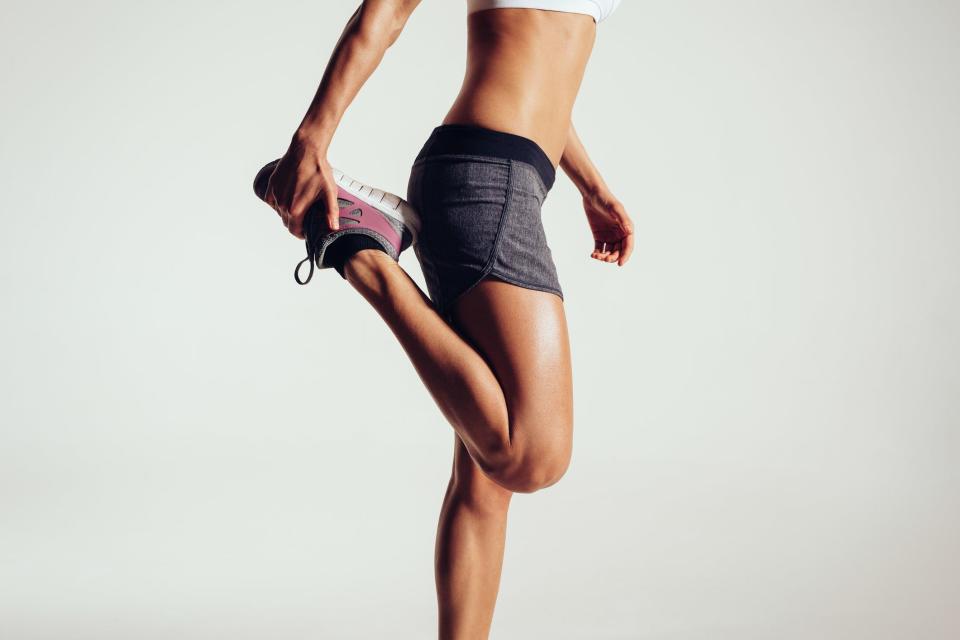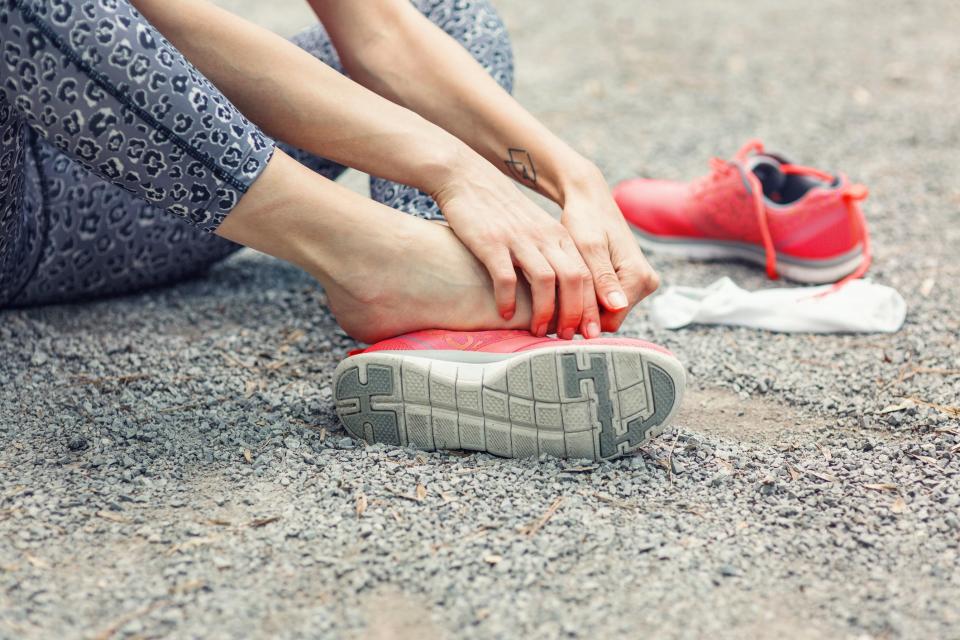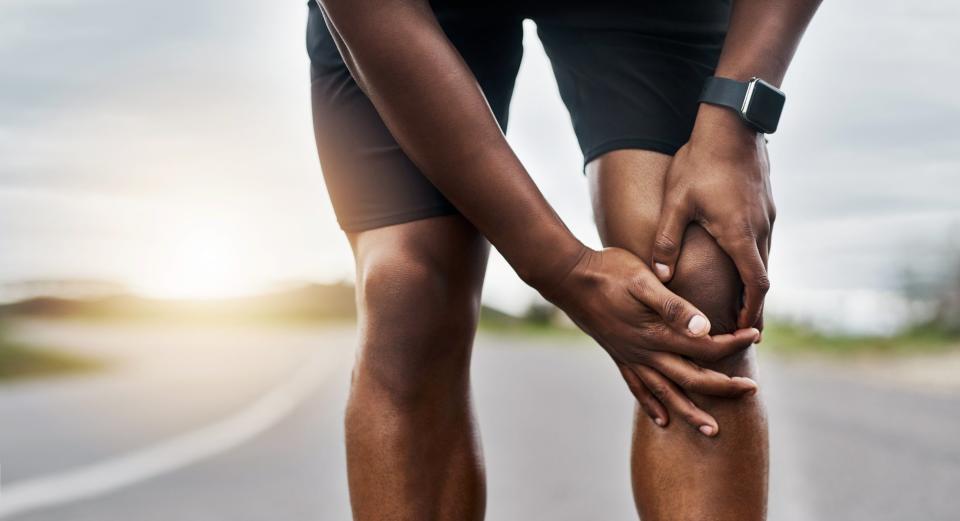London Marathon: Tips on how to recover, according to running experts

If you’ve ever run a marathon, you’ll know all too well the beating that your mind and body endures during the 26.2-mile race.
From battling searing heat as more than 40,000 runners did at the 2018 London Marathon – the hottest on record – and the chafing that’s involved with wearing a polyester-lined carrot onesie for charity, it’s no wonder many runners want to lie horizontal in bed for a week post-race.
This year, the London Marathon has been replaced with a small elite race and a virtual race for all other runners, having originally been due to take place on 26 April. While the marathon was initially postponed until 4 October due to the coronavirus pandemic, it was later cancelled completely.
More than 45,000 runners who were meant to take part in the London Marathon in April will instead complete the race on their own this Sunday, mapping out their own 26.2-mile routes.
The absence of fellow competitors and thousands of spectators will likely make this Sunday’s virtual London Marathon a surreal experience for all participants, all of whom will need to take extra special care looking after their bodies when in recovery post-race.
“The worst thing to do after a marathon is to sit down immediately as your muscles can seize up and cramp,” warns running group Track Life LDN co-founder Omar Mansour.
In the lead-up to Sunday’s virtual London Marathon, here’s everything you need to know about recovering from a marathon, from how to stretch and what to eat to massages and blisters.
What will be happening to the body after a marathon?
Once you’ve completed the marathon, while your first thought might be to celebrate with those in your household and enjoy a well-deserved pint, your body will be in “repair mode”.
“Microscopic tears in your muscles, endured over the 26.2 miles will now be evident in the form of as DOMS (delayed onset muscle soreness) and fatigue due to accumulation of waste products,” explains Lucie Cowan, group exercise ambassador and personal trainer at London-based gym Third Space.
“Your muscles will now undergo a process of repair, which can last up to two weeks,” she adds.
“Your immune system will also be on high alert, as these microscopic muscle tears have leaked proteins such as myoglobin into your bloodstream, causing inflammation, which then lead to free radical released, which also attack the tissue.”
This explains why your body feels so sore after a run. “Cellular damage form increased myoglobin levels in the blood can persist for more than seven days post-marathon,” Cowan adds.
Blood glucose levels and the stores of carbohydrate energy in the blood will also have been almost depleted, which often results in dehydration, no matter how much fluid you’ve consumed during the race.
“There’s a delay in the time it takes to get water through your system and into your bloodstream,” Cowan explains.
In the first 10 minutes after the race, what should you prioritise doing?

If you remember just one thing after the marathon, it should be to keep moving.
Adidas runners captain Ayo Dada says this will “gradually reduce your heart rate, flush out the toxins out of your legs and keep the muscles from seizing up for at least 10 to 15 minutes”.
“A beer may sound tempting after logging in all those miles but it’s crucial you replenish your depleted glycogen stores and provide some protein to your damaged muscle fibres at least 60 minutes after the race,” he adds. “Have some electrolytes or a protein shake to further aid recovery.”
However, be sure to sip these drinks continuously, rather than gulping them in one go to avoid feelings of nausea.
Staying warm should also be a top priority. Soon after the race, try to change into dry, warm clothes as soon as possible to avoid getting a chill.
Mansour advises: “Keep your body warm by putting something over you so that your body temperature doesn’t drop rapidly.”
Should you stretch immediately after the race?

Whether you’re someone who wouldn't dream of running without a preparatory 30-minute stretch involving hip flexors, or can happily take to the streets at a moment’s notice, the need to stretch after a race will depend on the individual.
However, the general rule is that you should wait at least a few hours before stretching or foam rolling in order to give your muscles time to recover from the race.
“There is no correlation between stretching and post exercise muscle soreness,” says Nike Trainer Luke Worthington. “However, if you enjoy stretching then by all means do so.”
For those partial to a sports massage post-race, Cowan advises waiting at least 24 hours before letting a masseuse at your limbs.
“This will allow your muscles time recover from the demands of the run and begin to replenish fluid and energy loss,” she says.
“Doing these things too soon may only add to your soreness. I’d opt for lightly foam rolling the following morning, followed by 10 minutes of dynamic mobility to ease the muscles and joints.”
Is it worth getting a post-race massage?
You should take caution before settling into the massage chair too soon after the run.
“You only have a small window of time straight after the race. It’s best to focus on getting warm, dry, refuelled and replenished slowly, rather than the tempting massage,” warns Cowan. She adds that a massage too soon after a race could “unknowingly exacerbate injuries and soreness”.
“Wait at least 24-48 hours for a massage if you feel its something you’ll benefit from,” she suggests.
Dada concurs, explaining that there is an ideal window post-marathon to undergo a massage.
“Like all Ferraris, after completing a marathon of miles it’s time for some MOT - similar to this, your body is a performance engine and needs immediate care,” he says.
“A post-race massage should be done within three to five days after your race to relive your body of tension and tissue impairments caused by the marathon.”
Should you have a cold or hot shower post-marathon?
If you don't fancy climbing into a bath of ice water to reduce muscle inflammation, you’re in luck.
Dada says a contrast shower – changing between a hot and cold shower – is ideal post-race for recovery. “This will help to encourage blood flow and help rush oxygenated blood to legs,” he says.
Cowan agrees, warning that there is conflicting evidence about the benefits and dangers of solely having either a hot or ice-cold bath post-exercise.
“A hot bath too soon after the race may increase inflammation, however it is now thought that an ice bath may go the other way and hinder recovery,” she explains.
To experience a contrast shower, Cowan suggests frequently alternating between cold and hot water every few minutes for your first shower after the race.
“The cold water causes vasoconstriction of the blood vessels in your legs (blood vessels to constrict), and the hot water causes vasodilation (blood vessels to enlarge), and it’s this oscillation between the vessels closing and opening which may aid the rush of oxygen-rich blood to your legs to promote recovery,” she adds.
Are there any foods and drinks to avoid?

A McDonald’s Big Mac Meal and a tub of Ben & Jerry's ice cream might be post-marathon fuel food of dreams but in reality, they won’t do you much good when it comes to your recovery, according to the experts.
“Junk foods high in sodium, such as pizzas, salty chips and burgers may seem like a good idea afterwards, due to their high calorific value, however foods high in salt lower your levels of potassium, which is of far greater importance to your recovery time than salt,” explains Cowan.
Worthington also warns runners to avoid diuretics such as caffeine and alcohol. “As tempting as the post-race prosecco might be, try to make sure your system has settled down before giving it anything else to deal with,” he says.
When it comes to sleep, what’s your top tip?
We all know the benefits of sleep (helps to reduce stress, lower blood pressure, improve mood etc) but catching Zzzs has never been more important than following a long run, argue the experts.
“Sleep is the greatest medicinal hack that no one ever paid attention to,” says Dada.
During sleep, human growth hormones (HGHs) are released which aid the repair of tiny muscles that are torn during the 26.2-mile race.
“This should be one of the best weeks of sleep you’re likely to experience in a long time, although the adrenaline high in the first instance may make it take you a while to drop off on the first night,” warns Cowan.
In order to reap the benefits of some well-earned shuteye, Cowan advises runners to avoid drinking excess fluids before bed and instead favour large carbohydrate and protein-heavy meals to prevent you waking up in the night with delayed onset hunger.
“If your DOMS are causing you difficulty in getting comfortable, try putting a pillow underneath your knees to lessen some muscle tension,” she suggests.
What’s the best way to look after your feet post-race?

While prevention may be better than cure (avoid wearing new trainers on race day and try taping your toes), it’s often impossible to avoid blisters following a long trudge on the road.
As a result, Worthington advises runners to slip out of their running shoes and into a pair of flip-flops or sliders as soon as possible. “This will let your feet breathe and heal,” he says.
It’s also important to take mental note of chafing or blisters in order to help you remember what kit to consider or avoid the next time you attempt to tackle a long run.
As for treatment, Cowan says lubrication or covering the blister, if it’s unpopped, with products like Vaseline or Dr. Scholl's Blister Defense, are the best forms of remedy to reduce friction to the area.
Meanwhile, Dada advises that if you’re desperate to exercise in the weeks after the marathon but are struggling with lingering blisters, try a non-impact sport such as cross-training or swimming which will cause minor skin irritation.
In terms of mental health, what’s the best way to boost your mood after the initial 'runner’s high'?
While it’s common to experience a sense of euphoria post-run thanks to a rush of endorphins and reduced anxiety, it’s not easily sustained in the days after a run.
Following a recommended 16-week training routine, it’s often hard to readjust to a steady exercise plan that doesn’t involve prolonged periods of jogging and carb-loading.
“For a runner, marathon recovery is mental as well and it’s important we address this alongside physical recovery,” says Dada. In the weeks following the marathon, he suggests taking part in fun activists to combat the “post-marathon blues” and give yourself time to recover.
“It’s important to be around like-minded people as you work your way back up to your original fitness pre-marathon," he says, advising to do an activity such as running with a friend.
That said, it’s important not to push yourself too soon into undergoing yet another sporting feat.
“We often find ourselves simply booking onto another race as soon as PMB (post-marathon-blues) kicks in, as we struggle to imagine the purpose of our lives without the goal and commitments surrounding it,” says Cowan.
As a result, she says it’s important to focus on the here and now, “the achievement as a whole from start to finish, regardless of the time you completed it in or the way you feel now compared to how you’d imagined”.
Cowan advises runners to write down three to five things which they’ve learned from training and race day, whether that’s a heavy squat personal best or a new-found love of the treadmill.
“Remind yourself that just because the race day is over, the long-term gains are more than just the number on the clock and the medal,” she says. “Slow down and enjoy all aspects of the present.”
If you feel the need to run soon after the race, Worthington says not to forget the joy of running pressure-free, without gruelling training plans and pace results.
“There is a reason why you signed up for an event like this and the chances are that reason still exists,” he says. “Run for fun.”
If you’re suffering from aches and pains, how should you treat them?

While the body might be sore after a marathon, it’s important to remember that the marathon experience doesn’t stop the minute you cross the finish line. There is still work to be done in order to help your body mend.
When it comes to working with post-marathon clients, Worthing advises runners to return to the gym three to four days after the run for a “shake out”. “This involves working on restoring mobility through the hips and upper back, and activating the core and postural musculature,” he says.
“On a case by case we may also work through some moderate intensity activity to help with blood flow to the most inflamed areas, speeding up the repair process.”
Cowan also suggests some dynamic stretching (a form of active movement) coupled with foam rolling the major muscles of the legs each day post-marathon “to help increase blood flow and promote recovery”.
However, if you continue to experience unusual symptoms of pain soon after the marathon, it’s advisable to contact a medical professional.
“If you are in muscular pain that doesn’t seem to be normal seeing a physio/sports masseuse the day after the marathon can be helpful,” says Mansour.
Is there a rule when it comes to how soon you can exercise after the marathon?
While many runners vow never to run a marathon soon after the race, it doesn’t take long for the majority to find themselves back on the treadmill or on the pavements within weeks given the satisfaction they’ve experienced of having become an accomplished athlete.
That said, runners should be careful as to when they start exercising again, as too soon post-marathon is a strict “no-no” according to the experts.
Mansour says: “Typically in the runners' world people say it takes a minimum of two weeks to recover from a marathon and that you should have two weeks of no running. However it is really down to the individual.”
Whether you hop back on the cycling bike or prefer to hang up your trainers for good post-marathon, it’s important to analyse how your body feels before rushing to test yourself too hard, too soon.
“Active recovery trumps total sedentary rest here,” says Cowan. “In the days after the marathon, your body probably won’t be up for running, but try to find alternative ways to move, in order to promote blood flow and recovery.”
This may include zero-impact cross training, low intensity cycling, or swimming. “If you do feel like attempting a run, take it easy and opt for a one to two miles on a soft surface such as grass,” she adds.
Here’s Cowan’s suggested training plan for the first week post-marathon:
Days 1-2: A walk or light session on the bike or in the pool following some dynamic stretching or foam rolling, if your muscles feel ready.
Days 3-4: A short bodyweight gym session and short trial brisk walk, following dynamic stretching and foam rolling
Days 4-5: swim or cycle and if it feels good to go, a short, slow run.
For all the latest news on the London Marathon, click here.
Read more
London Marathon 2020 live stream: How to watch race online and on TV this weekend
Nike says it has improved the shoe so good it became controversial
Dog named Cactus finishes desert marathon after epic run across Sahara
Cinema chain showing all 22 Marvel films in a 59 hour marathon
London Marathon 2019 runners to battle strong winds and heavy rains
8 best running watches for beginners to ultra marathon runners


